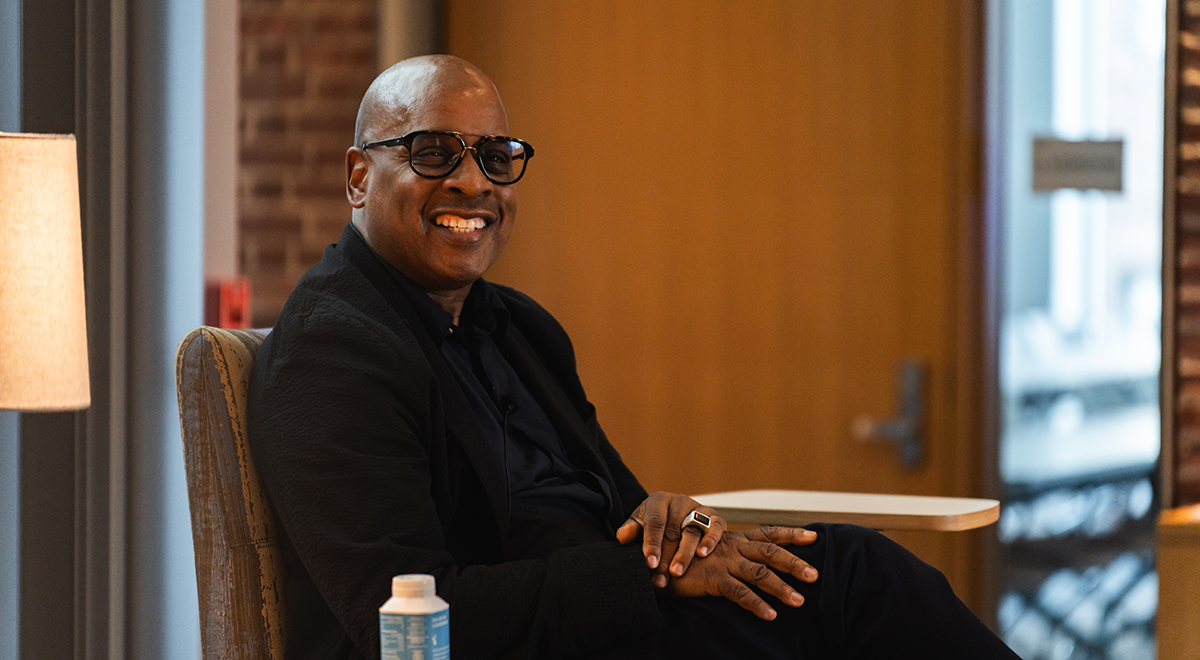Glenn Ligon ’82, Hon. ’12 Talks Career, Work at Pruzan Art Center

Artist Glenn Ligon ’82, Hon. ’12 spoke with Associate Professor and Program Director for Art History and Associate Professor of American Studies Claire Grace on Nov. 1 in the Frank Center for Public Affairs during Homecoming and Family Weekend 2024. The exhibition, Reading Signs: Jasper Johns and Glenn Ligon in Print, which features etchings and lithographs by both artists as well as screenprints by Johns from the Davison Art Collection, is on display at the Pruzan Art Center in the Goldrach Gallery through Dec. 11.
In her introduction to the conversation, Grace noted that Ligon’s work has been at the forefront of considerations of history, race, sexuality, and political culture in the United States since the late 1980s. “Many of us regularly and necessarily turn to your work and really treasure it in our teaching,” Grace said.
Ligon spoke of his undergraduate studies at Wesleyan with Jacqueline Gourevitch GP ’26, David Schorr, and Professor of Art History Emeritus John Paoletti. “My professors here had an enthusiasm for art, which made me enthusiastic for art,” Ligon said as he thanked Paoletti, who was in the audience for the talk.
Ligon’s work often incorporates text from literary sources such as Zora Neale Hurston, James Baldwin, and Ralph Ellison, inserting their voices into his paintings. “In some ways, the texts that I was drawn to were kind of out of print,” Ligon said, noting that Hurston was not quite included in general discussions about literature at the time he was introduced to her work while at Wesleyan.
“In a way, I felt like I was resurrecting that source material,” Ligon said. “But also, I think I was interested in these moments of Black visibility, and how we often, in the culture, go in and out of visibility.”
Grace noted the tension between painterly gesture and textual citation in many of Ligon’s works. Ligon incorporated passages from Hurston’s 1928 essay, “How It Feels to Be Colored Me,” into a suite of four etchings in 1992. “I’m reading something and if it sticks in my head enough, I figure out a way to use it,” Ligon said.
He described his repetitive process of stenciling letters with an oil stick, which transforms the work from crisp clean letters into abstraction. “I realized that the process of repetition and the material smearing and smudging was the most interesting thing about it,” Ligon said. “And so I should embrace that method I’ve set up and let the paint do what it wants to do because it added this layer of complexity to the sentence.”
“For me, I think you figure out what your work is about when you make it, not before you make it,” Ligon said. “So I’m always figuring out the work as I’m making it.”
Ligon described another work in the Wesleyan exhibition, the nine photo etchings in Narratives (1993), as being inspired by his interest in the constraints of the autobiographies written by former enslaved people. He called his work an uncomfortable declaration about the legacy of slavery. “The enslaved narrative has to be written with a particular audience in mind—a sympathetic white audience that will be converted to the anti-slavery cause by the performing of humanity in the writing of the text,” Ligon said. “You can’t really talk about the violence of the plantation, because that might offend somebody who could be your ally, so it’s veiled, often.”
For the ten lithographs in the work Runaways (1993), also on display in the Pruzan Art Center, Ligon said he had asked friends to write descriptions of him as if he had gone missing, and they had to describe him to the police. “I took their descriptions and slotted them into this format that kind of mimicked these advertisements in southern newspapers before the end of the Civil War for escaped enslaved people,” Ligon said, referencing his interest in the collapse of the historical distance between the present moment and traces of slavery. “I think a lot of my work is about that, or does that, or wants to think about that.”
Grace and Ligon also discussed Rückenfigur (2009), a neon and paint work currently on display at the Whitney Museum of American Art in New York, which reverses some letters in the word ‘America.’ Ligon said the work is an example of him applying the Jasper Johns maxim “Take an object / Do something to it / Do something else to it. [Repeat.]” to words.
“The idea of America as something that we imagine we all agree on what it is—and it’s clear that we do not agree on what that word means or what it could mean—so taking that simple word, that’s a very complex problematic word, and running it through all these changes is part of what that series is about,” he said.

